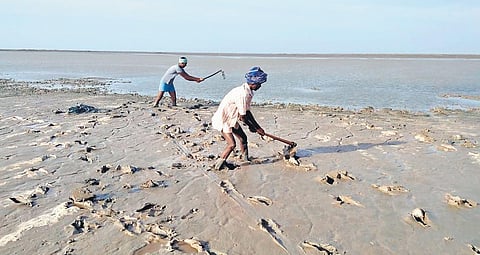

THIRUVARUR/THANJAVUR: Range Forest Officer A Thaheer Ali says there are multiple factors for the degradation of mangroves in the area, major ones being hypersalinity and siltation. Mangroves are salt-tolerant species and they depend on a delicate balance of fresh and seawater, and are often referred to as tidal forests.
“Generally, Muthupet gets fresh water for six months, from July to December. This year, due to the extended north-east monsoon, there was flow until the second week of January. It is during the summer that the tidal water stagnates and its evaporation occurs, leading to hypersaline condition smothering the low-salt tolerant mangrove species, especially the young ones,” he said.
Additionally, the six distributaries of Cauvery river – Nasuviniar, Pattuvanachiar, Paminiyar, Koraiyar, Kilaithangiar, and Marakkakoraiyar – that flush fresh water into Muthupet have silted-up. Also, these distributaries hardly receive any inflow, thanks to the presence of dams and barrages upstream. V Selvam, former director of Coastal Systems Research project at the Chennai-based MS Swaminathan Research Foundation (MSSRF), said that the final nail in the coffin was the Gaja cyclone, which uprooted almost every tree here and brought in thousands of tonnes of silt.
TNIE visited the Muthupet mangrove forest on February 1. It was mostly grey than green. Though there is some amount of natural regeneration happening on the coastline where there is tidal flushing, the interior forest areas are filled with dead mangrove litter and buried under silt. Forest guards, S Ganeshan and B Shivaneshan, have been serving at the Muthupet forest range for the past three decades and have seen this wetland evolve.
They showed The New Indian Express at least half-a-dozen spots which were once a dense jungle, with giant canopy, and now resemble a “wood depot” with uprooted trees, broken trunks and branches strewn all around.
Despite October-February being a peak season for migratory water birds, we spotted hardly any during the five-hour long boat ride, except for a few resident egrets and darters. Muthupet was once, a favourite wintering ground for more than a hundred species of migratory water birds, including the Grey Pelican, Greater Flamingo, Terns and Teals.
(This story was produced with support of Internews’ Earth Journalism Network) To be continued...